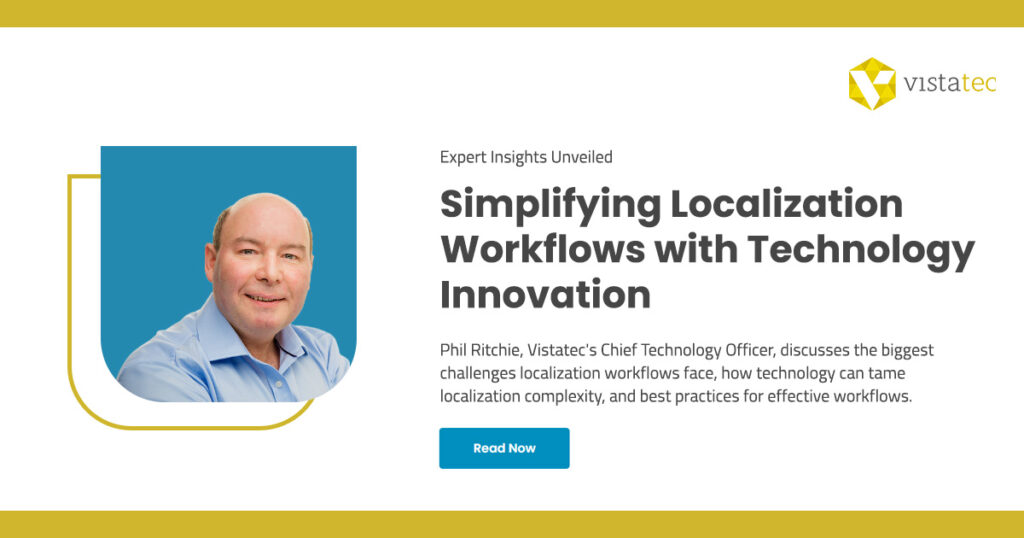

Subscribe to this content series and be the first to be notified when new content is released
Subscribe to this content series and be the first to be notified when new content is released
Simplifying Localization Workflows with Technology Innovation
An interview with Phil Ritchie, Vistatec’s Chief Technology Officer
Localization projects are surprisingly complex, especially at the enterprise level, where agile and continuous localization workflows exist. The translation process itself is the tip of the iceberg. There’s an ocean of tasks beneath the surface, including managing large amounts of content in diverse file formats across multiple tools and platforms, quality assurance, compliance, third-party review, and coordinating the multi-functional team that makes it all happen.
One of the key challenges is making this complicated endeavor as straightforward and effective as possible. Meet Phil Ritchie, Vistatec’s Chief Technology Officer. Phil constantly experiments with technological innovations to optimize enterprise customer programs’ productivity, efficiency, and transparency. Phil is the driving force behind Vistatec’s founding membership of the ADAPT Centre, contributor to the W3C standards and Okapi Framework, lead architect of the Ocelot open-source project, and regular participation in EU projects on localization standards, Natural Language Processing (NLP), Semantics and Linked Data.
We spoke with Phil to get his insights on successfully simplifying complex localization programs, including those with tens of thousands of jobs per month, and how he brings clients closer to the goal of straightforward and streamlined localization.
What are the biggest challenges you see when managing the different localization components efficiently?
Phil: With larger, ongoing projects, we’re dealing with an array of elements beyond the actual content. We’re managing different file types (some of which are easier to edit than others). We’re translating various types of content: marketing materials, software interfaces, websites, documents, and so much more. Each job requires a different approach, not just in language, formatting, and QA but also in terms of larger questions like process management and automation, metadata, capturing business data, and reporting.
Another aspect for consideration is that the tools and technologies involved are diverse and specialized: Translation Management Systems (TMS) for tracking and managing workflow, Translation Memories (TMs) for re-using pats translations, Machine Translation (MT) for speed and efficiency, and QA tools for maintaining and enforcing high quality standards.
Each tool plays a unique role, and managing them effectively requires a deep understanding of their strengths and limitations. There’s no one-size-fits-all solution. Some tools try to meet all of these needs simultaneously, but there’s usually a compromise in functionality: the “jack-of-all-trades” tools are masters of none. That’s why we often build custom integrations and tools for long-term enterprise customers.
Each tool also generates precious data, including linguistics, quality, and performance data. This data is critical for business reporting and strategic decisions. Managing this data is another challenge, especially since many tools don’t talk to each other without custom integrations.
What best practices for localization workflows have you identified that can simplify the localization process?
Phil: In my experience, the most effective and efficient workflows have five key features in common: they are customized, data-driven, modular, and as future-proof as possible. And they’re straightforward to use even when there’s a lot of complexity behind the scenes.
Each element plays a vital role, and they all interconnect to form a comprehensive strategy that makes it possible to manage these complex processes without an army of people. The goal is to continuously improve quality, cost, and speed while making life easier for our customers.
The first thing is customization: I tailor every workflow aspect to the client’s specific needs. This approach includes considering the type of content, the desired outcomes, and any other needs to create a personalized approach for each program.
Then there’s data-driven decision-making. A key focus of mine is how to centralize data from each client’s various tools. This focus could be data on translation quality, client feedback, or efficiency metrics. Consolidating data allows us to have a holistic view of our processes, and from there, we can identify trends, predict potential issues, and adapt our strategies accordingly. The more data we have available in our tools and processes, the better the results. Also, data fuels AI customization, and more and more of the technologies we are discussing integrate with AI.
Next is modularity: My mission has been to streamline by finding and implementing tools and technologies for each aspect of the job. It’s like building with LEGOS, where you can swap in and out pieces (technologies) to create the best possible build for each customer. This approach allows us to be agile and responsive. If a particular part of the workflow needs a specific tool, I figure out how to integrate it seamlessly, which often means developing custom solutions to bridge gaps between different technologies.
Then there’s future-proofing: The localization industry continually evolves, with new technologies and market demands emerging constantly. The rise of artificial intelligence is just one example. I always try to think two steps ahead of these changes, not only meeting our customers’ current requirements but also planning ahead to meet their needs in the future. I design workflows to be flexible and adaptable, ready to incorporate new tools and methods as they become available.
To give an example, when I look at the data, I might see the need for a new tool or a different method in a particular area of the workflow. I can apply a customized, modular approach to integrate this new tool with any other tools in use. I’m always thinking ahead so that today’s workflow will continue to serve our clients well into the future.
Lastly, it has to be user-friendly: Not everyone involved in localization is a tech guru, and they shouldn’t have to be in order to use the tools we build. I focus on simplifying complex processes so that our customers’ teams are empowered to succeed without losing the underlying data.
These practices work in synergy to make sure we get results that meet and exceed customer expectations.
Can you share how this approach to localization adds value beyond basic translation services?
Phil: At the core of my work is the mindset of going beyond the traditional scope of localization. Global businesses are not just translating content; they need to thrive in a global context, so my work focuses on that. That means I always try to deeply understand our customers’ businesses and processes and build solutions to support them.
I have found that often, you can build a solution that solves 80% of the problem, but doing that extra 20% is what really maximizes the value. I always look for that 20% because when it comes to automating processes, it’s often that final 20% that drives the big wins.
Enterprise localization is complex, but your experience with it shouldn’t be
With Phil as our leader in technology and workflow, our goal is to provide more than just localization services. We aim to empower our clients to excel globally. This means going above and beyond to understand their business objectives and aligning our services to help them achieve these goals, including creating sophisticated customized workflows using the latest technology the industry has to offer.
Are you ready to take your global business to the next level? Let us help you navigate the complexities of localization and unlock new opportunities in the global market. Contact us today to learn more about our innovative approaches and how we can tailor them to your specific needs.
As part of our Insights Unveiled series, each month we are releasing new perspectives and insights on the current and future landscape of the localization industry. Sign up below to ensure you don’t miss out on more insights, answers, and predictions about the future of localization!

Sign up to this content series and be the first to be notified when new content is released
Sign up to this content series and be the first to be notified when new content is released

